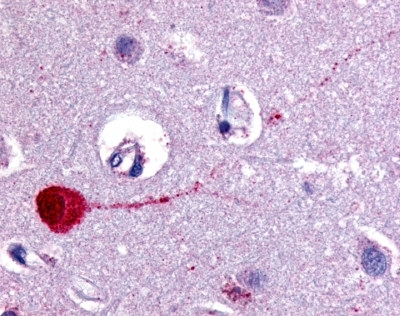Muscarinic Receptor M3 antibody

Rabbit anti Human Muscarinic Receptor M3
- Product Type
- Polyclonal Antibody
- Isotype
- Polyclonal IgG
- Specificity
- Muscarinic Receptor M3
| Rabbit anti Human muscarinic receptor M3 antibody detects the muscarinic receptor M3, a G protein-coupled receptor for acetylcholine which is expressed in smooth muscle and glandular tissues. The M3 subtype is coupled to other G proteins known as Go or Gq which activate phospholipase C leading to an increase in intracellular Ca2+. The M3 muscarinic receptor controls smooth muscle contraction in blood vessels and lungs as well as in the gastrointestinal tract. It is also located in many glands, and its activation helps to stimulate secretion. Mutations in the CHRM gene can lead to the development of Prune Belly Syndrome (PBS), a condition characterized by weak abdominal musculature, lax overlying skin, cryptorchism and urinary tract abnormalities (Weber et al. 2011). |
- Target Species
- Human
- Species Cross-Reactivity
-
Target Species Cross Reactivity Mouse Expected from Sequence - N.B. Antibody reactivity and working conditions may vary between species.
- Product Form
- Purified IgG - liquid
- Antiserum Preparation
- Antisera to human muscarinic receptor M3 were raised by repeated immunisations of rabbits with highly purified antigen. Purified IgG prepared by affinity chromatography.
- Buffer Solution
- Phosphate buffered saline
- Preservative Stabilisers
- <0.1% Sodium Azide (NaN3)
- Immunogen
- Synthetic peptide corresponding to the 3rd cytoplasmic domain of human muscarinic receptor M3, conjugated to Keyhole Limpet Hemocyanin (KLH)
- Approx. Protein Concentrations
- IgG concentration 0.5 mg/ml
- Regulatory
- For research purposes only
- Guarantee
- 12 months from date of despatch
Avoid repeated freezing and thawing as this may denature the antibody. Storage in frost-free freezers is not recommended.
| Application Name | Verified | Min Dilution | Max Dilution |
|---|---|---|---|
| Immunohistology - Paraffin 1 | 10ug/ml |
- 1This product requires antigen retrieval using heat treatment prior to staining of paraffin sections.Sodium citrate buffer pH 6.0 is recommended for this purpose.
- Histology Positive Control Tissue
- Brain, cortex.
| Description | Product Code | Applications | Pack Size | List Price | Your Price | Quantity | |
|---|---|---|---|---|---|---|---|
| Goat anti Rabbit IgG (Fc):Biotin | STAR121B | E WB | 1 mg |
|
Log in | ||
| List Price | Your Price | ||||||
|
|
Log in | ||||||
| Description | Goat anti Rabbit IgG (Fc):Biotin | ||||||
| Goat anti Rabbit IgG (Fc):FITC | STAR121F | F | 1 mg |
|
Log in | ||
| List Price | Your Price | ||||||
|
|
Log in | ||||||
| Description | Goat anti Rabbit IgG (Fc):FITC | ||||||
| Goat anti Rabbit IgG (Fc):HRP | STAR121P | E WB | 1 mg |
|
Log in | ||
| List Price | Your Price | ||||||
|
|
Log in | ||||||
| Description | Goat anti Rabbit IgG (Fc):HRP | ||||||
| Goat anti Rabbit IgG (H/L):HRP | STAR124P | C E WB | 1 mg |
|
Log in | ||
| List Price | Your Price | ||||||
|
|
Log in | ||||||
| Description | Goat anti Rabbit IgG (H/L):HRP | ||||||
| Sheep anti Rabbit IgG:RPE | STAR35A | F | 1 ml |
|
Log in | ||
| List Price | Your Price | ||||||
|
|
Log in | ||||||
| Description | Sheep anti Rabbit IgG:RPE | ||||||
| Description | Product Code | Applications | Pack Size | List Price | Your Price | Quantity | |
|---|---|---|---|---|---|---|---|
| Antigen Retrieval Buffer, pH8.0 | BUF025A | P | 500 ml | Log in | |||
| List Price | Your Price | ||||||
| Log in | |||||||
| Description | Antigen Retrieval Buffer, pH8.0 | ||||||
References for Muscarinic Receptor M3 antibody
-
Billington, C.K. & Penn, R.B. (2002) m3 muscarinic acetylcholine receptor regulation in the airway.
Am J Respir Cell Mol Biol. 26 (3): 269-72.
Further Reading
-
Felton, J. et al. (2018) Targeting M3 Muscarinic Receptors for Colon Cancer Therapy.
Curr Mol Pharmacol. Jan 18 [Epub ahead of print]. -
Pronin, A.N. et al. (2017) Teaching an Old Drug New Tricks: Agonism, Antagonism, and Biased Signaling of Pilocarpine through M3 Muscarinic Acetylcholine Receptor.
Mol Pharmacol. 92 (5): 601-612.
- RRID
- AB_906091
- UniProt
- P20309
- Entrez Gene
- CHRM3
- GO Terms
- GO:0004435 phosphatidylinositol phospholipase C activity
- GO:0004981 muscarinic acetylcholine receptor activity
- GO:0005887 integral to plasma membrane
- GO:0006112 energy reserve metabolic process
- GO:0006464 protein modification process
- GO:0007399 nervous system development
- GO:0050796 regulation of insulin secretion
- GO:0008283 cell proliferation
- GO:0016323 basolateral plasma membrane
- View More GO Terms
- GO:0030054 cell junction
- GO:0045211 postsynaptic membrane
AHP1355
If you cannot find the batch/lot you are looking for please contact our technical support team for assistance.
Please Note: All Products are "FOR RESEARCH PURPOSES ONLY"
View all Anti-Human ProductsAlways be the first to know.
When we launch new products and resources to help you achieve more in the lab.
Yes, sign me up